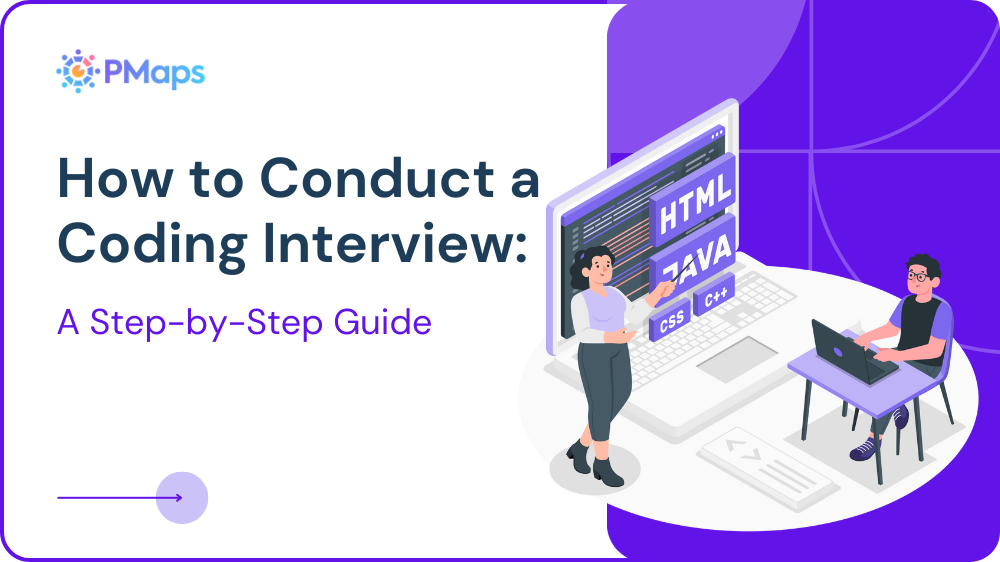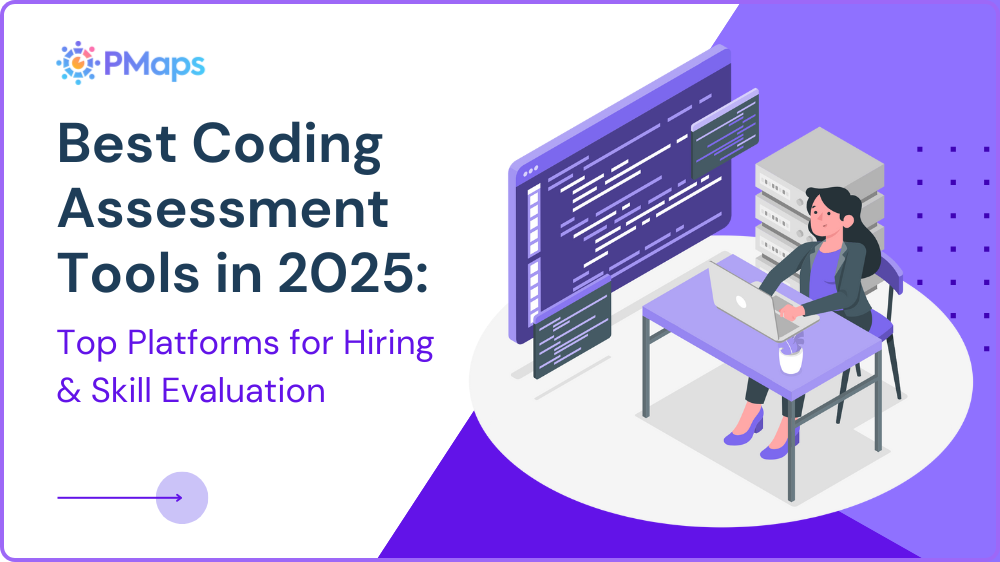
How to Conduct a Coding Interview: A Step-by-Step Guide
To conduct a coding interview that feels fair and useful, start with empathy. Candidates arrive nervous. Interviewers juggle calendars. You still need strong signals fast. A simple, consistent flow keeps stress low and results clear for both hiring teams and applicants.
Think about your goals first. You want evidence of real problem-solving, not party-trick puzzles. You also want a positive candidate experience that protects your brand. This guide walks you through a practical process you can reuse across roles, levels, and locations.
What Is a Coding Interview?
A coding interview is a structured conversation where you ask candidates to solve programming problems in real time. It’s not just about whether they can write code—it’s about how they think while writing it.
Unlike take-home projects, coding interviews happen live, often within a set time frame. The candidate writes code while the interviewer observes, asks clarifying questions, and evaluates their reasoning. Some interviews use simple algorithmic tasks, while others mirror real-world challenges like debugging or building small features.
Think of it this way: you’re not only measuring technical skill, but also spotting collaboration style, communication habits, and how gracefully someone handles pressure. When done well, the session feels more like a working session with a future teammate than a test.
Why Coding Interviews Matter
Resumes tell stories; coding interviews show the plot unfolding. Live problem-solving reveals thinking, communication, and calm under bumps. With one structured hour, teams gather clean signals, reduce bias, and protect candidate experience—without scheduling marathons or guessing based on polished portfolios.
- Live sessions show choices, trade-offs, and recovery after mistakes.
- One format, one rubric: apples-to-apples comparisons across interviewers.
- Collaboration signal: questions, narration, and willingness to accept small hints.
- Debugging under pressure predicts production steadiness.
- Better experience builds brand; respectful rejections still earn referrals.
Types of Coding Interviews
Before we choose a format, let’s agree on the goal: clear signal with minimal drama. Pick the style that reveals how a candidate thinks, collaborates, and steadies under pressure. Here’s a practical checklist:
- Online IDE live task: Great for quick signal without travel logistics. You watch the problem-solving unfold. Think “trial lap,” not a full race.
Use when: you need speed and consistency.
Watch for: copy-paste habits and silent typing.
- Pair-programming session: You solve a small problem together. It feels like a real workday, minus the coffee refill.
Use when: collaboration matters as much as syntax.
Watch for: listening skills, turn-taking, and gentle course corrections.
- Targeted debugging round: Provide a buggy snippet and a failing test. Ask them to steady the ship.
Use when: maintenance and reliability rule the roadmap.
Watch for: hypothesis, instrumentation, and calm under stack traces.
- Code reading and refactor: Hand over a “legacy” function. Invite improvements without heroic rewrites.
Use when: you value clarity, naming, and safe changes.
Watch for: small, reversible steps and thoughtful tests.
- Take-home with review call: Candidates build a tiny feature on their own time. You later discuss choices.
Use when: you want asynchronous depth and a calmer pace.
Watch for: originality, test coverage, and realistic scope control.
- Scenario walkthrough: Present a short brief: new endpoint, rate limits, and a cranky cache. Discuss trade-offs.
Use when: product constraints shape the code.
Watch for: questions first, code second; clear assumptions.
- System design lite
Keep it scoped: a service, a queue, and a deadline. No need for planetary diagrams.
Use when: senior roles need architectural judgment.
Watch for: simple designs that scale without drama. - Data-oriented round: Query a dataset, fix an off-by-one, then chart a final insight.
Use when: roles blend engineering with analytics.
Watch for: sane queries, edge cases, and readable results.
- Language-specific depth probe: Focus on one runtime: memory, concurrency, or package hygiene. No trivia lightning rounds.
Use when: the stack is fixed and deep.
Watch for: precise explanations and safe idioms.
- Culture-of-code check: Review a small PR together. Discuss naming, comments, and commit messages.
Use when: code review norms matter to team health.
Watch for: respectful feedback and rationale over taste.
How to Structure a 60-Minute Coding Interview
A tight hour works when everyone knows the beats. Set expectations early, keep friction low, and gather repeatable signals. Think warm welcome, sharp prompt, guided depth, and a clean wrap. Here’s a simple, reusable flow your team can adopt without ceremony or chaos.
0–5 min: Welcome and setup
Interviewer does: Introduce roles, outline the agenda, confirm tools.
Signal to collect: Communication clarity, baseline comfort.
Tip: Share evaluation criteria up front to lower nerves.
5–10 min: Problem briefing
Interviewer does: Present a scoped task with inputs, outputs, and constraints.
Signal to collect: Questioning, assumption checks, planning.
Tip: Invite the candidate to restate the problem in their words.
10–35 min: Live problem-solving
Interviewer does: Observe, nudge with small hints, protect focus.
Signal to collect: Decomposition, correctness, testing approach, trade-offs.
Tip: Ask for narration: “Talk me through your next step.” You can also use Behavioral Event Interviewing Structures.
35–50 min: Deep dive and extensions
Interviewer does: Add an edge case, performance twist, or minor refactor.
Signal to collect: Debugging method, complexity awareness, code hygiene.
Tip: Request a quick test or sanity check before changes.
50–60 min: Wrap and questions
Interviewer does: Summarize observations, share next steps, invite questions.
Signal to collect: Reflection, receptiveness to feedback, curiosity.
Tip: Leave two minutes for the candidate’s questions—brand matters.
Alternative AI Interviews with Automated Scheduling
When calendars are packed or applicant volume spikes, automation earns its keep. AI-run interviews gather consistent signals without herding diaries across time zones. Think of them as a tidy front door: they trim noise early and keep strong candidates moving without delay.
AI Video Interviewing brings structure without the scheduling dance. Candidates record answers on their own time, responding to the same prompts for fair comparison. Auto-transcripts make reviews quick and searchable, while tone, pacing, and facial cues reveal communication style. Limited retries reduce camera jitters and lead to clearer signals.
AI Voice Interviewing suits bandwidth-limited candidates and phone-first regions. A short, guided call captures clarity of speech, listening, and thinking aloud—useful for support, field tech, or entry roles. Setup is light, drop-offs are lower than long forms, and instant summaries help recruiters triage faster.
Use these formats as early screens for large pools, after a take-home to add context, or when teams span many time zones. They standardize inputs before expert live rounds, protect candidate time, and reflect well on your brand by giving swift, respectful responses—even when the answer is no.
What to Assess: A Reusable Rubric
Keep scoring tight and predictable. Share this rubric upfront, collect evidence during the session, and grade on behavior, not vibes. The four-point scale works well: 1 below bar, 2 mixed, 3 hire signal, 4 strong hire signal.
Before scoring, align the panel on what matters. Use a simple rubric that pairs coding assessment tools or your coding assessment platform with live signals. Treat it like a coding skills assessment: same prompts, same bar, consistent notes. Here’s a compact checklist for clear, apples-to-apples evaluation.
- Problem framing — Clarifies goals, constraints, edge cases.
- Decomposition — Breaks work into small, named steps.
- Correctness & tests — Working code plus basic checks.
- Debugging method — Hypothesize, instrument, change one thing.
- Communication — Narrates intent, asks clarifiers, accepts hints.
Anti-Cheating and Fairness, the Right Way
Cheating fears rise when pressure and ambiguity meet. Reduce both. Share format, tools allowed, and time limits in advance. Use coding assessment tools with safe mode, paste limits, and session logs. Then focus on behavior: how candidates reason, not just what they type.
- Clear rules beat traps. Publish what’s open book, what’s not, and why.
- Randomized seeds help. Same stem, varied data; equal difficulty across attempts.
- Proctoring with restraint. Screen capture or keystroke logs, plus privacy guidance.
- Detect patterns, not people. Flag suspicious paste spikes; review context before judging.
- Evidence over guesswork. Save transcripts, diffs, and test runs for calm debriefs.
Fairness starts with access. Prefer browser IDEs that run on modest machines. Offer a low-bandwidth mode and a pause for connectivity blips. For accessibility, support screen readers, larger fonts, and keyboard-only navigation. Equal footing creates cleaner signals and protects your brand.
Bias shrinks when structure grows. Calibrate questions by level and maintain a common rubric. Rotate interviewers to balance styles. In debriefs, ban adjectives like “smart” or “polished.” Cite actions: added a failing test, simplified loop, handled nulls. Consistent notes enable consistent hiring.
Finally, separate intent from outcome. A candidate who names constraints, tests early, and adjusts with feedback shows hireable habits—even if the final edge case slips. Your coding assessment platform should capture those behaviors, so promising talent is not lost to nerves or network jitter.
Common Mistakes to Avoid in Coding Assessments
Even solid processes wobble under pressure. A few small fixes prevent most headaches and keep your coding assessment tools and live rounds clean. Treat this like a preflight: short, calm checks before you launch another interview day.
- Vague prompts — Missing inputs, outputs, or limits create guesswork. Add one line that states constraints plainly.
- Trivia traps — Method names from memory don’t predict real work. Focus on reasoning and small, testable steps.
- Moving targets — Mid-interview scope changes confuse everyone. Save extensions for a planned deep-dive window.
- Silent sessions — Ask for narration. “Talk me through your next step” unlocks signals without coaching.
- Uneven scoring — Share the rubric up front. Note actions, not adjectives. Compare like with like.
- Tool friction — Long setup kills momentum. Prefer a browser IDE inside your coding assessment platform.
- Overproctoring — Heavy surveillance spikes anxiety. Use light checks, clear rules, and review context before judging.
- No feedback — One sentence of behavior-based feedback protects the brand and helps strong candidates return better.
Conclusion
Keep interviews simple, humane, and repeatable. Share the plan, use a steady rubric, and collect evidence over opinions. Pair live rounds with coding assessment tools for scale, and lean on your coding assessment platform for clean notes and debriefs. When the process feels like real work, your coding skills assessment signals stay strong. If you want to try ready-to-use coding assessments, call 8591320212 or write to assessment@pmaps.in









